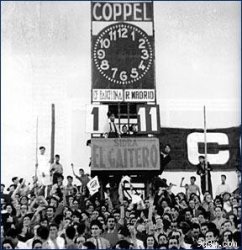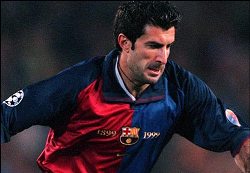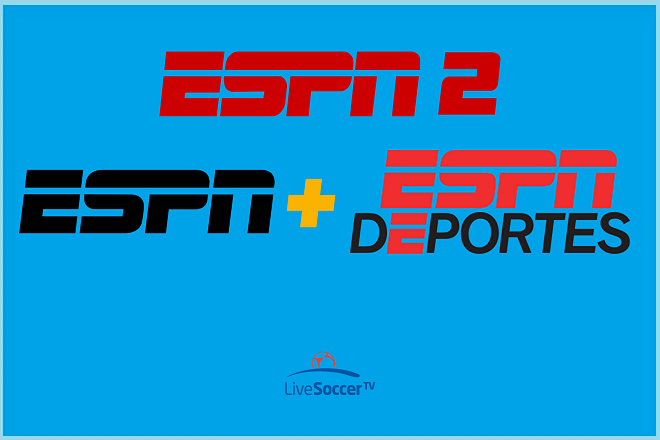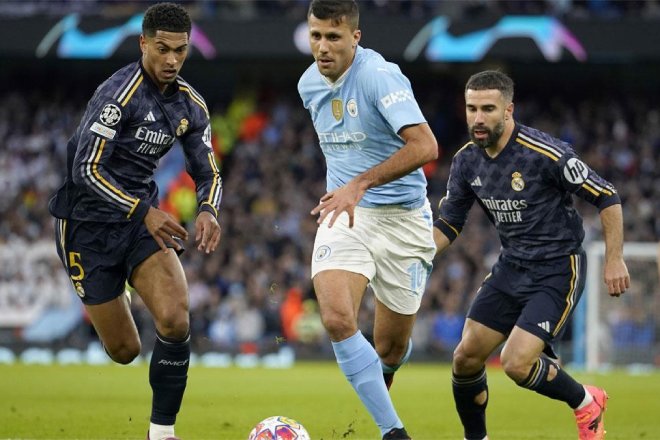.gif) With football, as with any sport, there is no more powerful reflection of greatness than to compete against a powerful arch-rival, a nemesis whose very existence fuels passion and against whom one’s own greatness is either confirmed or found wanting. Seabiscuit, for example, had War Admiral. Muhammad Ali had Joe Frazier. Lance Armstrong had Jan Ullrich.
With football, as with any sport, there is no more powerful reflection of greatness than to compete against a powerful arch-rival, a nemesis whose very existence fuels passion and against whom one’s own greatness is either confirmed or found wanting. Seabiscuit, for example, had War Admiral. Muhammad Ali had Joe Frazier. Lance Armstrong had Jan Ullrich.
Such a nemesis serves to enhance, perhaps even define, a competitor’s greatness, and no competition can be considered truly successful unless the nemesis has been vanquished. And yet, as so often occurs in titanic sporting tussles, greatness may be confirmed for loser and winner alike.
Few rivalries in sport can compare with the spectacle, the passion, and the sheer football brilliance of a match between Spanish football titans Real Madrid FC and FC Barcelona. And any meeting between the two is known simply, elegantly, and without overstatement as “El Clasico.”
The rivalry between Real Madrid an FC Barcelona transcends football. It represents a clash of cultures between the Castilian Spanish and the Catalan. To some it represents a clash of the established order versus a progressive social movement. And to others, it may still represent the forces of oppression versus those of freedom and equality.
Such attributes and more, good and bad, have been invested in El Clasico over the decades. But for the true football fan, a match between Real Madrid and FC Barcelona quite simply represents a great football match between two great clubs.
From The First Clasico Through The Post Spanish Civil War Era
The first ever encounter between the two clubs occurred on May 13, 1902. Barcelona won that match 3-1, and even today that loss appears a difficult one for the Real Madrid faithful to swallow. The official Real Madrid website, revealing a hint of sour grapes, attributes Barcelona’s win to “the six foreigners they lined up.”
The bloody and reprisal-ridden Spanish Civil War that raged across Spain from 1936 until 1939 played a powerful part in fueling the rivalry between the two clubs. Real Madrid was seen to represent the imposition of Spanish culture and Francisco Franco’s Nationalist agenda on the fiercely proud Catalans of Barcelona, who supported the Republican side in the conflict.
Indeed, with Franco’s victory came the imposition of proscriptions against the cultural and linguistic differences of groups such as the Basques the Catalans and others.
This period witnessed a growth in membership of FC Barcelona. By joining the club Catalans could demonstrate their differences, celebrate their way of life and give voice to their language. FC Barcelona became “mes que un club,” more than a club, to Catalans as well as to progressives and left-leaning Spaniards across the country.
On the field Real Madrid tended to dominate when the two clubs met. From 1925 through 1952 Real won 22 of their league matches while Barcelona won 13. Cup ties were nearly even in that same period, with Barcelona taking a slight edge with 4 victories to Madrid’s 3. However, it was during this period that Barcelona suffered their worst ever defeat to their rivals, losing the second leg of the 1943 Copa Del Rey semi-final 11-1 in Madrid!
 Alfredo Di Stefano Fuels the Rivalry
Alfredo Di Stefano Fuels the Rivalry
In 1953 a new Real Madrid emerged, led by a young Argentine whom many would later call the greatest player ever. His name was Alfredo Di Stefano, and his acquisition by Real under convoluted circumstances fueled the intensity of the rivalry between Real and Barcelona.
Di Stefano had been plying his trade in Colombia for Millionarios when he was spotted by both Spanish clubs. He actually belonged to the famous Argentine club River Plate, but was on loan to the Colombians due to a player’s strike in Argentina.
Real and Barcelona both sent emissaries to South America and protracted and complicated negotiations took place involving the Colombian and Argentine clubs, the Spanish clubs and the two South American countries’ football federations. In the end FIFA, the governing body of world football, sanctioned Di Stefano’s transfer to FC Barcelona.
The Spanish Football Federation, however, stepped in and refused to allow the transfer, simultaniously banning any foreigners from playing in Spain. One might be forgiven for reading into this the possibility of a Madrid bias. FIFA refused to weigh in on the matter any further and negotiations over Di Stefano’s future resumed. While this was happening Real Madrid president Santiago Bernabeu persuaded Di Stefano to sign for Real.
The dispute was seemingly settled when the Spanish Federation announced that Di Stefano would be allowed to play four years in Spain, two for Barcelona and two for Real.
Barcelona backed out of the deal, and some would argue that their action was motivated by the political leanings of their government-imposed president at the time.
With Di Stefano firmly attached to Real Madrid, the die was now cast for a period of Real Madrid hegemony over the European football scene and the club went on to win the Spanish Championship in consecutive season as well as the European Cup five times in a row.
Transfers - and Luis Figo - Reignite the Rivalry
The transfer of players between the two great rivals is, as one can imagine, beset with controversy, and of such matters are rivalries stimulated.
So bitter, for example, is the rivalry between Liverpool and Manchester United in England that no player has crossed that divide since 1961. The same cannot be said of the Real-Barcelona rivalry, because through the years a number of notable players have crossed over between the two clubs.
Although the Di Stefano’s transfer debacle—albeit not, strictly speaking, between the two rivals-- was the most notable of the first half of the 20th Century, the second half saw numerous transfers in both directions. The great Dane Michael Laudrup, for example, went from Barca to Madrid. Bernd Schuster went from Barca to Real, while later Luis Enrique went the other way from Madrid to Barca.
Each such move reinvigorated the rivalry. The most celebrated transfer however, and the one that has caused the most intense reaction, was the transfer of Luis Figo from Barcelona to Real in 2000.
Portuguese superstar Figo was the first signing of Real Madrid’s Galacticos era and in terms of the enmity his signing created, he is certainly the most spectacular purchase.
Figo at the time was the toast of Barcelona, for whom he had played since 1995. His move to Real Madrid was seen by Catalans as a betrayal and they never let him forget it.
The occasions of Figo’s return to the Camp Nou were greeted with vitriol and missiles, the most extravagant armament launched at him being the head of a pig, hurled along with golf balls, bottles and other varieties of detritus while he was lining up to take a corner kick in 2002.
It was in that year, 2002, that the two clubs met in Champions League action. They had met before in the European Cup, the world’s preeminent club championship, notably in the early ‘60s, with each club coming away the winner once. In 2002 they met at the semi final level and in the first leg Real came away the winner at the Camp Nou by a score of 0-2. This match was said to have been watched by over 500 million people worldwide, and has been called “the match of the century.”
 Head-to-Head El Clasico Results
Head-to-Head El Clasico Results
Since their first encounter in 1902 Real Madrid and Barcelona have met each other on 208 occasions in league, cup and European contests. Real Madrid has the edge, with 85 wins to Barcelona’s 81. There have been 42 draws.
Their next meeting, on Monday, November 29, is as much anticipated as any Clasico previously played. Indeed, so intense is the notoriety for this match that there are reports the game will be televised live on the big screen TVs in New York’s Times Square.
How fitting that the greatest football rivalry in the world should be showcased in the greatest city in the world! There is no doubt the match will live up to the expectations.
To read more about Real Madrid click here.
To read more about FC Barcelona, click here.
























